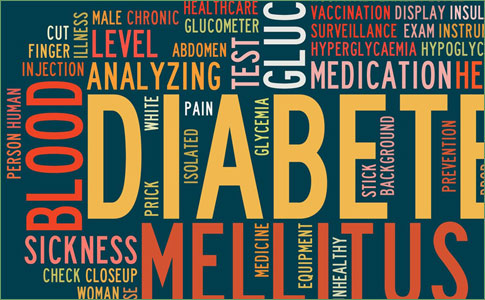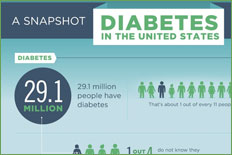Health Centers > Diabetes Center > Chronic Complications of Diabetes > Diabetic Nephropathy
Diabetic Nephropathy
As many as 4000 cases of end-stage renal disease occur each year among diabetic people in the United States. This is about one-third of all patients being treated for end-stage renal disease and represents a considerable national health expense.
Diabetes Chronic Complications
Ocular complications
L Diabetic cataracts
L Diabetic retinopathy
L Glaucoma
Diabetic Nephropathy
L Microalbuminuria
L Progressive diabetic nephropathy
Diabetic Neuropathy
L Peripheral neuropathy
L Autonomic neuropathy
Cardiovascular complications
L Heart disease
L Peripheral vascular disease
Skin and Mucous membrane complications
Special Situations
Prognosis
The cumulative incidence of nephropathy differs between the two major types of diabetes. Patients with type 1 diabetes have a 30-40% chance of having nephropathy after 20 years - in contrast to the much lower frequency in type 2 diabetes patients, in whom only about 15-20% develop clinical renal disease.
However, since there are many more individuals affected with type 2 diabetes, end-stage renal disease is much more prevalent in type 2 than in type 1 diabetes in the United States and especially throughout the rest of the world. Improved glycemic control and more effective therapeutic measures to correct hypertension - and with the beneficial effects of ACE inhibitors - can reduce the development of end-stage renal disease among diabetics.
Diabetic nephropathy is initially manifested by proteinuria; subsequently, as kidney function declines, urea and creatinine accumulate in the blood.
1. Microalbuminuria - Sensitive radioimmunoassay methods of detecting small amounts of urinary albumin have permitted detection of microgram concentrations - in contrast to the less sensitive dipstick strips, whose minimal detection limit is 0.3-0.5%. Conventional 24-hour urine collections, in addition to being inconvenient for patients, also show wide variability of albumin excretion, since several factors such as sustained erect posture, dietary protein, and exercise tend to increase albumin excretion rates. For these reasons, a timed overnight urine collection or albumin-creatinine ratio in an early morning spot urine collected upon awakening is preferable.
Normal subjects excrete less than 15 mcg/min during overnight urine collections; values of 20 mcg/min or higher are considered to represent abnormal microalbuminuria. In the early morning spot urine, a ratio of albumin (mcg/L) to creatinine (mg/L) of < 30 mcg/mg creatinine is normal, and a ratio of 30-300 mcg/mg creatinine suggests abnormal microalbuminuria. At least two of three timed overnight or early morning spot urine collections over a 3- to 6-month period should be abnormal before a diagnosis of microalbuminuria is justified.
Subsequent renal failure can be predicted by persistent urinary albumin excretion rates exceeding 30 mcg/min. Increased microalbuminuria correlates with increased levels of blood pressure and increased LDL cholesterol, and this may explain why increased proteinuria in diabetic patients is associated with an increase in cardiovascular deaths even in the absence of renal failure. Glycemic control as well as a low-protein diet (0.8 g/kg/d) may reduce both the hyperfiltration and the elevated microalbuminuria in patients in the early stages of diabetes and those with incipient diabetic nephropathy. Antihypertensive therapy also decreases microalbuminuria.
The Hypoglycemic States
Spontaneous hypoglycemia in adults is of two principal types: fasting and postprandial. Symptoms begin ...
Diabetes Complications
The major cause of the high morbidity and mortality rate associated with...
Chronic Complications of Diabetes
Late clinical manifestations of diabetes mellitus include a number of pathologic changes ...
Diabetes Cardiovascular complications
Cardiovascular disease risk is increased in patients with type 1 diabetes...
Complications of Insulin Therapy
Hypoglycemic reactions, the most common complication of insulin therapy...
Diabetic Nephropathy
As many as 4000 cases of end-stage renal disease occur each year among diabetic people in the United States...
Diabetic Neuropathy
Diabetic neuropathies are the most common complications of diabetes affecting...
Evidence from some studies - but not the UKPDS - supports a specific role for ACE inhibitors in reducing intraglomerular pressure in addition to their lowering of systemic hypertension. An ACE inhibitor (captopril, 50 mg twice daily) in normotensive diabetics impedes progression to proteinuria and prevents the increase in albumin excretion rate. Since microalbuminuria has been shown to correlate with elevated nocturnal systolic blood pressure, it is possible that "normotensive" diabetic patients with microalbuminuria have slightly elevated systolic blood pressure during sleep, which is lowered during antihypertensive therapy. This action may contribute to the reported efficacy of ACE inhibitor drugs in reducing microalbuminuria in "normotensive" patients.
2. Progressive diabetic nephropathy - Progressive diabetic nephropathy consists of proteinuria of varying severity occasionally leading to nephrotic syndrome with hypoalbuminemia, edema, and an increase in circulating LDL cholesterol as well as progressive azotemia. In contrast to all other renal disorders, the proteinuria associated with diabetic nephropathy does not diminish with progressive renal failure (patients continue to excrete 10-11 g daily as creatinine clearance diminishes). As renal failure progresses, there is an elevation in the renal threshold at which glycosuria appears.
Hypertension develops with progressive renal involvement, and coronary and cerebral atherosclerosis seems to be accelerated. Approximately two-thirds of adult patients with diabetes have hypertension. Once diabetic nephropathy has progressed to the stage of hypertension, proteinuria, or early renal failure, glycemic control is not beneficial in influencing its course. In this circumstance, antihypertensive medications, including ACE inhibitors, and restriction of dietary protein to 0.8 g/kg body weight per day are recommended.
ACE inhibitors have been shown to protect against deterioration in renal function in type 1 diabetic patients with clinical nephropathy. This beneficial effect appears to be due to improved glomerular hemodynamics that cannot be explained only by the antihypertensive action of these drugs. Captopril (25 mg three times daily) has shown a 50% reduction in the risk of the combined end points of death, dialysis, and transplantation in type 1 subjects with diabetic nephropathy and clinical proteinuria. During initiation of ACE inhibitor therapy, an increment in serum creatinine greater than 2 mg/dL due to a rapid fall in intraglomerular pressure - or the occurrence of persistent hyperkalemia (above 6 mEq/L) due to hyporeninemic hypoaldosteronism - is an indication to stop this medication.
Dialysis has been of limited value in the long-term treatment of renal failure due to diabetic nephropathy. At present, experience in renal transplantation - especially from related donors - is more promising and is the treatment of choice in cases where there are no contraindications such as severe cardiovascular disease.
Daily Diabetes News
Rice study details stress-diabetes link
That control lies with the brain’s executive functions, processes that handle attention, inhibition, working memory and cognitive flexibility and are also involved in reasoning, problem-solving and planning.
The study…


